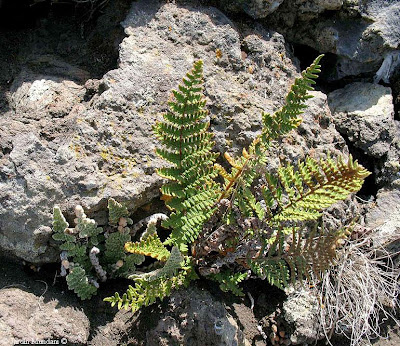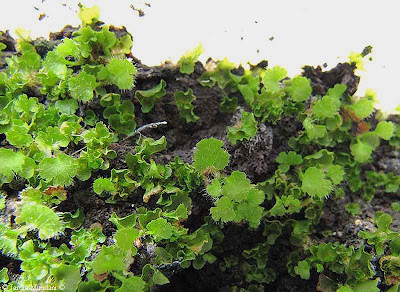The fern Cosentinia vellea is a heliophilous and thermophilic species that together to Notholaena marantae and some Cheilanthes are adapted to live in full sun, making it an exception in the world of ferns. Belongs to the family of Hemionitidaceae and may have a diploid chromosome number of 58 chromosomes (2n = 58, n = 29), Cosentinia vellea subsp. bivalens or have its genome duplicated by apomeiosis, ie autotetraploid, with 116 chromosomes (2n = 116, n = 58), Cosentinia vellea subsp. vellea. Since the phenotype of both subspecies is virtually identical to distinguish them it must done a chromosome count or measure the size of the spores, somewhat smaller in the diploid subspecies.
Vigorous Cosentinia vellea at early May, living in full sun with scorching heat and blinding glare. Is rooted between volcanic stones that hold the ashes of the volcano Teneguía south of the Canary island of La Palma. I was surprised by his good looks against all logic, as at that time I believe it had a temperature above 40 º C. However their fronds were well spread and turgid, unequivocal proof of its excellent hydration. Kneeling on the ash making photos I discovered his secret. If you doing double click on image to enlarge you will note that the ash where rooted Cosentinia is very humid. On the left are even small hepatics and a little moss, something amazing with the torrid heat and the intense drought of the semidesertic southern of Isla Bonita.
When I returned to the car, I understood the mystery of the moisture that allows the small fern lives very comfortable. The slopes of the volcano Teneguía leading down to the sea are covered with vines grown intelligently by exploiting the same strategy as Cosentinia, the porosity of the lava and volcanic ash, like sponges that absorb moisture from the sea breeze every morning rises from the Atlantic Ocean, soak the surface of the lava and, thanks to its porosity, the sweet water coming from the sea seeps into the deep underground, where have its roots the Cosentinia and the vines. Even if they spend months without rain these plants do not suffer from thirst and remain lush throughout the long summer canary. It is the same phenomenon of horizontal rain in laurel forests, replacing the tops of the trees by the volcanic lava, as in both cases the sea breeze condenses the moisture on the leaves in the forests and on the lava in semi-desert coastal areas, leaving thousands of tons of sweet water, without need of normal rain.
When I returned to the car, I understood the mystery of the moisture that allows the small fern lives very comfortable. The slopes of the volcano Teneguía leading down to the sea are covered with vines grown intelligently by exploiting the same strategy as Cosentinia, the porosity of the lava and volcanic ash, like sponges that absorb moisture from the sea breeze every morning rises from the Atlantic Ocean, soak the surface of the lava and, thanks to its porosity, the sweet water coming from the sea seeps into the deep underground, where have its roots the Cosentinia and the vines. Even if they spend months without rain these plants do not suffer from thirst and remain lush throughout the long summer canary. It is the same phenomenon of horizontal rain in laurel forests, replacing the tops of the trees by the volcanic lava, as in both cases the sea breeze condenses the moisture on the leaves in the forests and on the lava in semi-desert coastal areas, leaving thousands of tons of sweet water, without need of normal rain.
Other beautiful copies on the slopes of the volcano Teneguía. In the Canary Islands it belong to the diploid subspecies, Cosentinia vellea subsp. bivalens. In the same habitat, lives another hairy fern, Notholaena marantae, that in Canary islands is the subcordata subspecies, which uses the same strategy as Cosentinia, including the hairs that protect them from the sun's rays and dehydration.
Here we see the two sun-loving ferns that wear wool coat. To the left there is a Cosentinia vellea with white wool coat and to the right a Notholaena marantae subsp. subcordata with brown-orange wool coat. (Double click on the photo to enlarge)
Here we see the two sun-loving ferns that wear wool coat. To the left there is a Cosentinia vellea with white wool coat and to the right a Notholaena marantae subsp. subcordata with brown-orange wool coat. (Double click on the photo to enlarge)
In a climate quite different from the canary, but using similar strategies, here we see a copy of Cosentinia vellea growing between the stones of a terrace facing south in the Valley of Soller on the island of Mallorca. In the Mediterranean islands, not having the contribution of moisture from the sea breeze, during the summer the hairy ferns enter in aestivation, dehydrate, shrink and wrap their fronds, takes on the appearance of a cotton ball and wait patiently to arrive the first rains of autumn, so that within 24 hours their fronds out the summer lethargy, rehydrated, leafing, expand, unwind and re-look the same a few months before, as if nothing had happened.
Frond of Cosentinia vellea covered by villi that allows to see the green surface of the pinnae. The fronds of Cosentinia have the petiole much shorter than the blade, which is bipinnate, oblong-lanceolate, with pinnules ovate to suborbicular, entire or deeply lobed in the lobes rounded and covered on both sides with woolly hairs multicellular, in a principle whitish and when aging become ferruginous.
Dense white hairs on the underside of the same previous frond that covers even the rachis, like a wool coat.
The sori are developed under the hairiness on the underside of the fronds. Enlarging the picture you can see the mature sporangia as black balls that are about to disperse the spores.
Cosentinia vellea oversized sporangium already deployed after the dispersal of spores. You see some spores that have been retained within the transparent bag.
Spores with beautiful intense dark red color. In this case do not exceed 60 microns and belong to bivalens subspecies.
Cosentinia vellea spores germinate very easily if grown in a lunchbox. In this image you can see several sporophytes of Cosentinia vellea, showing the typical villi of the species.











No comments:
Post a Comment